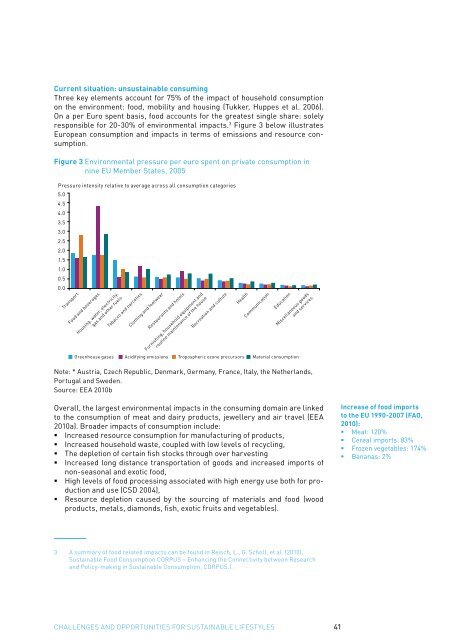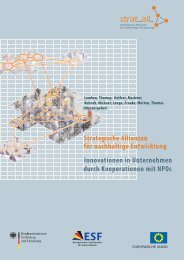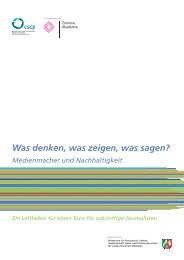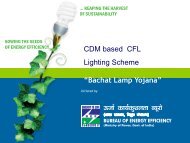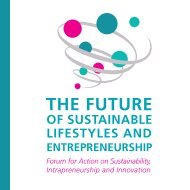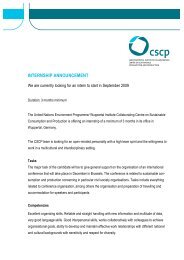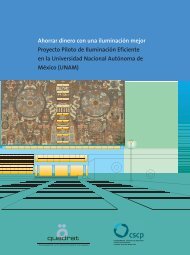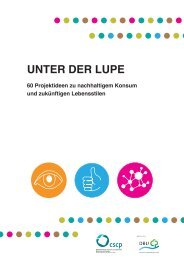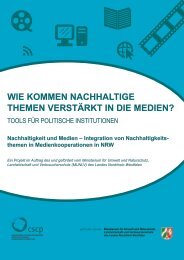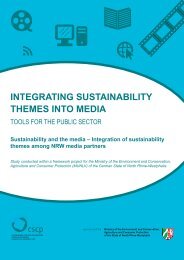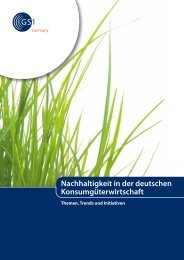today's facts & tomorrow's trends - SPREAD Sustainable Lifestyles ...
today's facts & tomorrow's trends - SPREAD Sustainable Lifestyles ...
today's facts & tomorrow's trends - SPREAD Sustainable Lifestyles ...
You also want an ePaper? Increase the reach of your titles
YUMPU automatically turns print PDFs into web optimized ePapers that Google loves.
Current situation: unsustainable consuming<br />
Three key elements account for 75% of the impact of household consumption<br />
on the environment: food, mobility and housing (Tukker, Huppes et al. 2006).<br />
On a per Euro spent basis, food accounts for the greatest single share: solely<br />
responsible for 20-30% of environmental impacts. 3 Figure 3 below illustrates<br />
European consumption and impacts in terms of emissions and resource consumption.<br />
Figure 3 Environmental pressure per euro spent on private consumption in<br />
nine EU Member States, 2005<br />
Pressure intensity relative to average across all consumption categories<br />
5.0<br />
4.5<br />
4.0<br />
3.5<br />
3.0<br />
2.5<br />
2.0<br />
1.5<br />
1.0<br />
0.5<br />
0.0<br />
Transport<br />
Food and beverages<br />
Housing, water, electricity,<br />
gas and other fuels<br />
Tobacco and narcotics<br />
Clothing and footwear<br />
Restaurants and hotels<br />
Furnishing, household equipment and<br />
routine maintenance of the house<br />
Recreation and cultute<br />
Greenhouse gases Acidifying emissions Tropospheric ozone precursors Material consumption<br />
Health<br />
Communication<br />
Education<br />
Miscellaneous goods<br />
and services<br />
Note: * Austria, Czech Republic, Denmark, Germany, France, Italy, the Netherlands,<br />
Portugal and Sweden.<br />
Source: EEA 2010b<br />
Overall, the largest environmental impacts in the consuming domain are linked<br />
to the consumption of meat and dairy products, jewellery and air travel (EEA<br />
2010a). Broader impacts of consumption include:<br />
• Increased resource consumption for manufacturing of products,<br />
• Increased household waste, coupled with low levels of recycling,<br />
• The depletion of certain fish stocks through over harvesting<br />
• Increased long distance transportation of goods and increased imports of<br />
non-seasonal and exotic food,<br />
• High levels of food processing associated with high energy use both for production<br />
and use (CSD 2004),<br />
• Resource depletion caused by the sourcing of materials and food (wood<br />
products, metals, diamonds, fish, exotic fruits and vegetables).<br />
Increase of food imports<br />
to the EU 1990-2007 (FAO,<br />
2010):<br />
• Meat: 120%<br />
• Cereal imports: 83%<br />
• Frozen vegetables: 174%<br />
• Bananas: 2%<br />
3 A summary of food related impacts can be found in Reisch, L., G. Scholl, et al. (2010).<br />
<strong>Sustainable</strong> Food Consumption CORPUS – Enhancing the Connectivity between Research<br />
and Policy-making in <strong>Sustainable</strong> Consumption, CORPUS.).<br />
Challenges and opportunities for sustainable lifestyles 41


